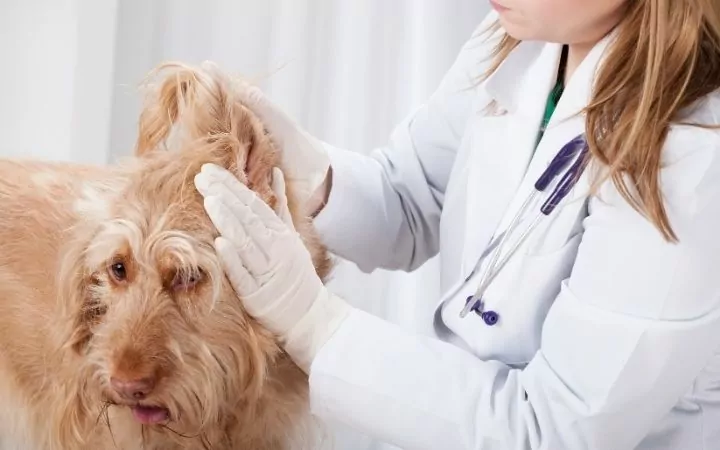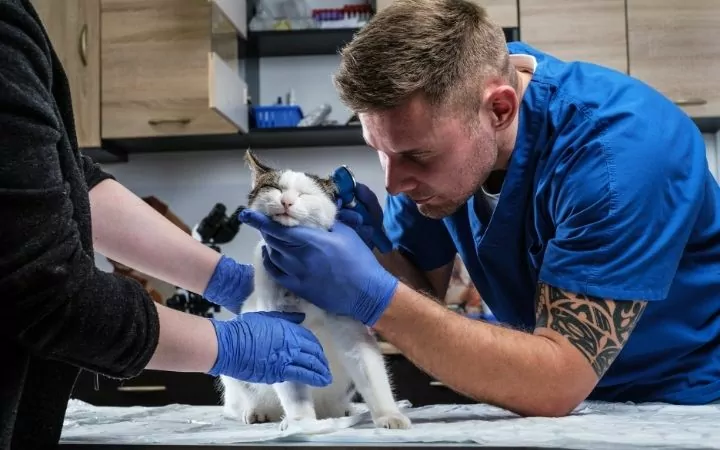About Aural Hematomas
Aural hematomas are a collection of blood that is confined within the ear flap (pinna). They can feel warm to the touch and feel fluctuant due to being filled with fluid. The skin above the hematoma can be pink or red.
In the pinna, blood vessels become damaged and bleed when your pet scratches, shakes aggressively or sustains trauma to the delicate tissue (e.g., dog bite). When blood vessels under the skin’s surface bleed, the blood fills the space between the ear cartilage and skin, causing a hematoma. It is important to know that aural hematomas are always secondary to something causing trauma to the ear, and the cause of the trauma also needs to be resolved.

The Occurrence of Aural Hematomas
Aural Hematomas can affect both dogs and cats. There is no age or gender predilection, but some animals can be more likely to develop aural hematomas:
- Dogs with large floppy ears are more likely to become damaged when shaking the head.
- Dogs who spend a lot of time in the grass, such as working dogs, are more likely to have grass seeds get stuck in the ear, leading to irritation and, therefore, an aural hematoma.
- Any condition that causes otitis (inflammation of the ear canal) can lead to an aural hematoma, e.g., dogs with allergies, dogs that spend lots of time in the water, and cats with ear mites.
Primary and Secondary Causes of Otitis in Cats and Dogs
As mentioned above, otitis is a common cause of aural hematomas. The ear canal’s inflammation can be caused by something directly affecting the skin lining the ear canal (primary) or other irritants touching the skin and causing inflammation (secondary).
Examples of causes of primary otitis are hypersensitivities such as contact reactions to irritants in the ear canal, food, and environmental allergies, problems with conformation, and inflammatory polyps.
Secondary otitis can be caused by bacterial and yeast infections, foreign bodies such as grass seeds, inner ear inflammation, and chronic ear changes such as untreated aural hematomas.

The Problem Definition of Aural Hematomas
Aural hematomas in and of themselves are not life-threatening nor an emergency. However, it is essential that if you think your pet has an aural hematoma, you bring them to the vet promptly to prevent scarring of the ear and help to relieve discomfort.
Draining the Swelling
Your veterinarian may recommend draining the hematoma to see if that can help treat it (medical management). The benefits of draining the swelling are that it is minimally invasive and more cost-effective than surgery.
Draining the hematoma is a good option for smaller hematomas that are treated quickly after they developed or for animals where anesthetic drugs need to be avoided. Often a steroid will be infused into the pocket once the fluid has been drained.
This may need to be repeated daily until the swelling resolves so it can be a commitment to get your animal resolved medically.
If draining doesn’t work or your veterinarian doesn’t feel it is the best option for your pet, another way to manage it would be surgically. This might be recommended in larger hematomas or older injuries where the blood has clotted and can not be drained.
Surgical treatment would involve either deep sedation or general anesthetic and a cut being made on the inside of the ear to drain the fluid. Stitches can then be placed to prevent the pocket from filling up again. Occasionally, your pet’s ear will be bandaged to its head to avoid further trauma.
If treatment doesn’t occur, the hematoma will eventually resolve, but it can cause permanent scarring, closing the ear canal. Not treating the hematoma may also cause discomfort and pain, so it is always recommended to have your pet seen, and the best course of action be decided between you and your veterinarian.

Treating Concurrent Ear Infections
As mentioned previously, aural hematomas are secondary to trauma; a common cause of the trauma is ear infections. An ear infection’s signs include scratching at one or both ears, yelping when ears are touched, the ears feeling hot to touch, and a strong smell from the ears.
Suppose you think your pet has an ear infection. In that case, it’s essential to get them seen by a veterinarian to have them treated to prevent aural hematomas and help resolve the discomfort caused by the infection itself.
Aural Haematomas Cats vs. Dogs
Both cats and dogs can get aural hematomas; they can both be managed in similar ways. The main difference is that, although in some cases dogs with aural hematomas can be left to heal without treatment, this is not recommended for cats.
This is because the cartilage inside cat ears is a lot more sensitive than dogs, so they are more prone to scarring and permanent disfigurement. This means it is essential to have your cat seen if you suspect an aural hematoma, as it needs to be treated quickly to prevent irreversible damage.

Aftercare and Outcome
Aural hematomas treated are expected to have a good outcome and can completely resolve with minimal scarring in both cats and dogs. In pets that do not have the aural hematoma treated, the result can vary depending on the hematoma’s original size and how long it takes to heal. Cauliflower ears, like those seen in rugby players, can be sequelae if left untreated.
If your pet is treated medically with the draining of the aural hematoma, the aftercare should be minimal, occasionally the ear will be bandaged, or your pet may need to wear a cone while it heals.
In some instances, your pet may need to be medicated at home while the ear is being managed.

Surgical treatment is more invasive and therefore requires more aftercare at home. Your pet will likely have stitches in their ear, which will need to be looked after and removed once the ear has healed.
Often the ear will be bandaged, and your pet could have a cone as well. An oral medication, including pain medicine, will likely be prescribed. Any sedated or anesthetized animal will come home slightly drowsy and may need to be looked after and kept warm while they recover.
If you are concerned about your pet after a procedure, contact your vet clinic for advice.
Summary
Although not life-threatening, aural hematomas can be a painful condition that should be looked at by your pet’s veterinarian. Aural hematomas are always secondary to some sort of trauma, so this must be investigated as well to relieve your pet of possibly another condition.
Treating the cause of the hematoma and the hematoma itself should completely resolve the problem and hopefully prevent it from recurring again.
